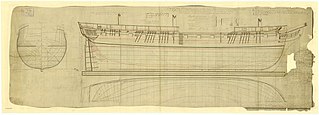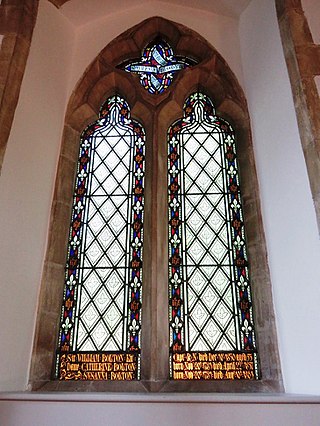
HMS Leander was a 50-gun spar-decked frigate of the Royal Navy which saw service in the Napoleonic Wars, the War of 1812, and the Second Barbary War.

HMS Endymion was a 40-gun fifth rate that served in the French Revolutionary Wars, the Napoleonic Wars, the War of 1812 and during the First Opium War. She was built to the lines of the French prize Pomone captured in 1794. Due to her exceptional handling and sailing properties, the Severn-class frigates were built to her lines, although the gunports were rearranged to mount an extra pair of guns per side, the ships were made of softwood and were not built until nearly the end of the Napoleonic Wars.

HMS Princess Charlotte, later HMS Burlington, was a 42-gun fifth-rate frigate of the Royal Navy built in 1814, during the War of 1812 at the Kingston Royal Naval Dockyard in Kingston, Ontario. She had originally been built as Vittoria, but was renamed before being launched. She was constructed to a design by George Record, and was built under a private contract by Master shipwright John Goudie. She served on Lake Ontario, having been commissioned at Oswego on 5 May 1814 under Captain William Mulcaster.
HMS Surprise was a 38-gun frigate of the Leda class of the Royal Navy, although all these fifth-rate frigates were re-classed as 46-gun under the general re-rating of February 1817, from when carronades on the quarterdeck and forecastle were included in the rating.
HMS Prince Regent was a 56-gun British warship that served on Lake Ontario during the War of 1812. Prince Regent was built at the Kingston Royal Naval Dockyard in Kingston, Upper Canada and launched on 14 April 1814. Rated as a fourth-rate frigate, Prince Regent took part in the Raid on Fort Oswego in 1814. Following the War of 1812 the frigate was renamed HMS Kingston on 9 December 1814. In 1817, the vessel was placed in reserve following the Rush-Bagot Treaty that demilitarized all the lakes along the United States-Canada border. Discarded in 1832, the vessel found no buyer and sank in Deadman Bay off Kingston after 1832.
HMS Niemen was a Royal Navy 38-gun fifth-rate frigate. She began her career as the Niémen, a 44-gun French Navy Armide-class frigate, designed by Pierre Rolland. She was only in French service for a few months when in 1809 she encountered some British frigates. The British captured her and she continued in British service as Niemen. In British service she cruised in the Atlantic and North American waters, taking numerous small American prizes, some privateers but mostly merchantmen. She was broken up in 1815, at the end of the Napoleonic Wars and the War of 1812.

Furieuse was a 38-gun frigate of the French Navy. The Royal Navy captured her in 1809 and took her into service as the fifth rate HMS Furieuse. She spent most of her British career in the Mediterranean Sea, though towards the end of the War of 1812 she served briefly on the North American station. She was laid up in 1815 and sold for breaking up in 1816.
William Mounsey CB was a British officer of the Royal Navy. He served during the American Revolutionary, the French Revolutionary and the Napoleonic Wars, rising to the rank of Captain.
HMS Eurydice was a 24-gun Porcupine-class post ship of the Royal Navy built in 1781 and broken up in 1834. During her long career she saw service in the American War of Independence, the French Revolutionary Wars and the Napoleonic Wars. She captured a number of enemy privateers and served in the East and West Indies, the Mediterranean and British and American waters.

HMS Castor was a 32-gun Amazon-class fifth-rate frigate of the Royal Navy. She served during the French Revolutionary and Napoleonic Wars. The French briefly captured her during the Atlantic Campaign of May 1794 but she spent just 20 days in French hands as a British ship retook her before her prize crew could reach a French port. Castor eventually saw service in many of the theatres of the wars, spending time in the waters off the British Isles, in the Mediterranean and Atlantic, as well as the Caribbean.
HMS Cydnus was one of eight Royal Navy 38-gun Cydnus-class fifth-rates. This frigate was built in 1813 at Blackwall Yard, London, and broken up in 1816.

Sir Henry Hope KCB was an English officer of the Royal Navy whose distinguished service in the Napoleonic Wars and the War of 1812 earned him acclaim. As captain of HMS Endymion, he was involved in the action on 14 January 1815 which ended in the capture of the American warship USS President.

HMS Orpheus was a 36-gun Apollo-class fifth-rate frigate of the Royal Navy launched in 1809 from Deptford Dockyard. She was broken up in 1819.

HMS Seahorse was a 38-gun Artois-class fifth-rate frigate of the Royal Navy. She was launched in 1794 and broken up in 1819.

HMS Doterel, was an 18-gun Cruizer-class brig-sloop of the British Royal Navy. Launched on 6 October 1808, she saw action in the Napoleonic Wars and in the War of 1812. In February 1809 she took part in the Battle of Les Sables-d'Olonne, then in April the Battle of Basque Roads. She was laid up in 1827 at Bermuda, but not broken up until 1855.

Captain Sir William Bolton was a post-captain in the Royal Navy who served under Nelson during the French Revolutionary Wars and was married to Dame Catherine Bolton, Nelson's niece. He also served in the Napoleonic Wars and the War of 1812.

HMS Royalist was launched in 1807. She captured many privateers and letters of marque, most French, but also some from Denmark and the United States. Her crew twice were awarded the Naval General Service Medal. She was instrumental in the capture of a French frigate. The Royal Navy sold her in 1819. She then became a whaler, making three complete voyages. She was condemned after a mishap while on her fourth.
HMS Nymphe was a 38-gun fifth rate frigate of the Royal Navy, launched on 13 April 1812 at Woolwich Dockyard, and commissioned later that month. She was a Lively class of 18-pounder frigates, designed by the Surveyor of the Navy, Sir William Rule. It was probably the most successful British frigate design of the Napoleonic Wars, to which fifteen more sister ships would be ordered between 1803 and 1812.
HMS Thames was a 32-gun fifth-rate Thames-class frigate of the Royal Navy, launched in 1805 at Chatham.

The Perseverance-class frigate was a 36-gun, later 42-gun, 18-pounder fifth-rate frigate class of twelve ships of the Royal Navy, constructed in two batches. Designed by Surveyor of the Navy Sir Edward Hunt the first iteration, consisting of four ships, was constructed as a rival to the similar Flora-class frigate. Strongly built ships, the Perseverance class provided favourable gunnery characteristics and was highly manoeuvrable, but bought these traits with a loss of speed. The name ship of the class, Perseverance, was ordered in 1779 and participated in the American Revolutionary War, but her three sister ships were constructed too late to take part. The class continued in service after the war, but soon became outdated.











